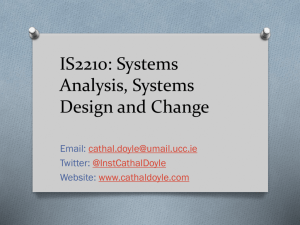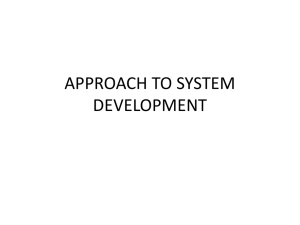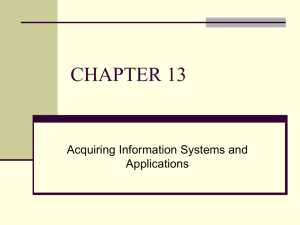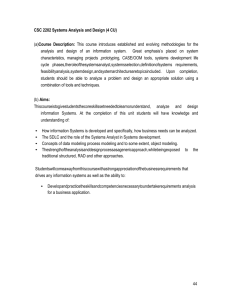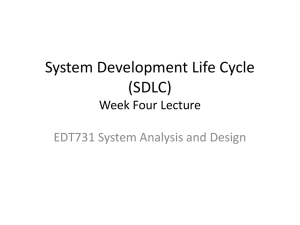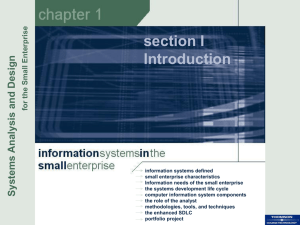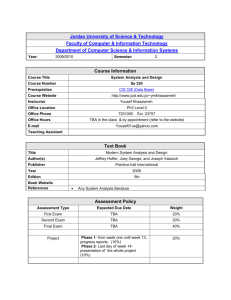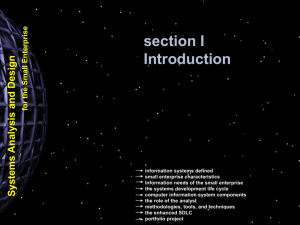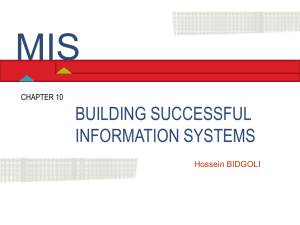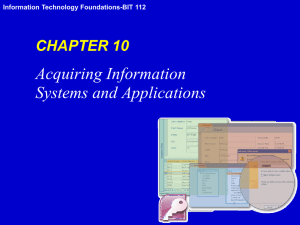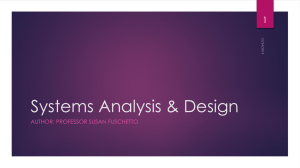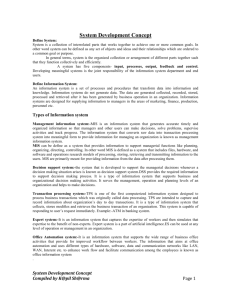Analysis Phase – Second phase in the SDLC that consists of two
advertisement
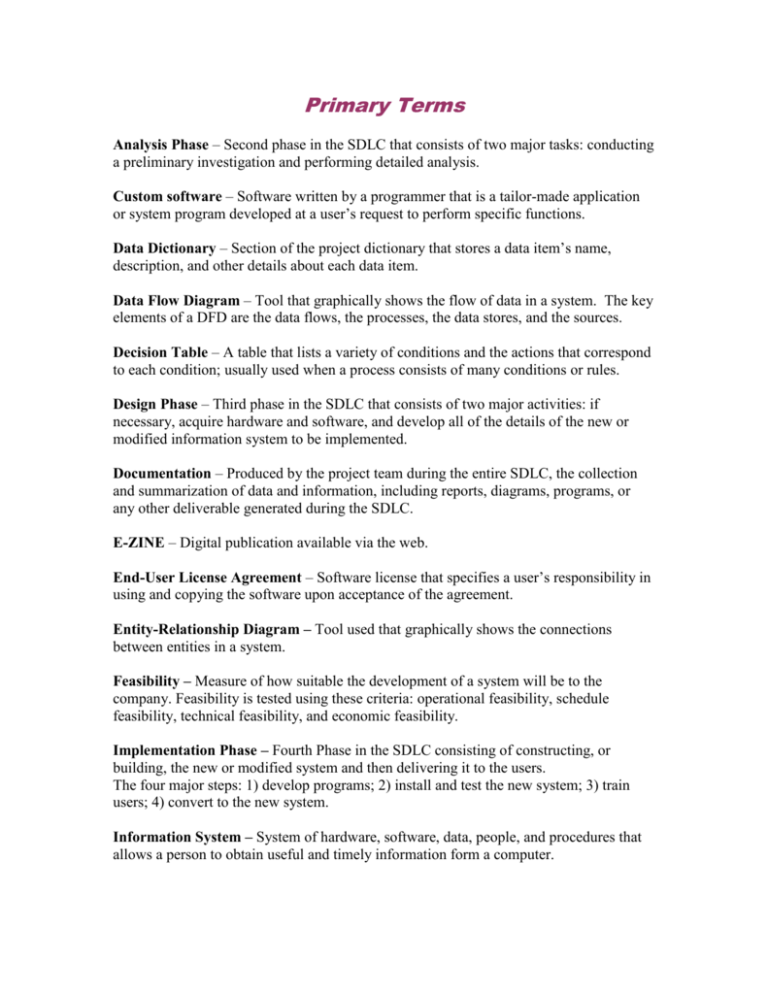
Primary Terms Analysis Phase – Second phase in the SDLC that consists of two major tasks: conducting a preliminary investigation and performing detailed analysis. Custom software – Software written by a programmer that is a tailor-made application or system program developed at a user’s request to perform specific functions. Data Dictionary – Section of the project dictionary that stores a data item’s name, description, and other details about each data item. Data Flow Diagram – Tool that graphically shows the flow of data in a system. The key elements of a DFD are the data flows, the processes, the data stores, and the sources. Decision Table – A table that lists a variety of conditions and the actions that correspond to each condition; usually used when a process consists of many conditions or rules. Design Phase – Third phase in the SDLC that consists of two major activities: if necessary, acquire hardware and software, and develop all of the details of the new or modified information system to be implemented. Documentation – Produced by the project team during the entire SDLC, the collection and summarization of data and information, including reports, diagrams, programs, or any other deliverable generated during the SDLC. E-ZINE – Digital publication available via the web. End-User License Agreement – Software license that specifies a user’s responsibility in using and copying the software upon acceptance of the agreement. Entity-Relationship Diagram – Tool used that graphically shows the connections between entities in a system. Feasibility – Measure of how suitable the development of a system will be to the company. Feasibility is tested using these criteria: operational feasibility, schedule feasibility, technical feasibility, and economic feasibility. Implementation Phase – Fourth Phase in the SDLC consisting of constructing, or building, the new or modified system and then delivering it to the users. The four major steps: 1) develop programs; 2) install and test the new system; 3) train users; 4) convert to the new system. Information System – System of hardware, software, data, people, and procedures that allows a person to obtain useful and timely information form a computer. Packaged Software – Copy-righted pre-written software available for purchase which meets the needs of a wide variety of users. Also called packaged commercial off-the-shelf software. Phases – Categories in the system development life cycle, including planning, analysis, design. Implementation, and support; Planning Phase – First phase in the SDLC which begins when the steering committee receives a project request. Activities performed during the planning phase include; review and approve the project requests prioritize the project requests, allocate resources to approved projects, and form a project development team for each approved project. Preliminary Investigation - Occurs during the analysis phase of the system analyst to decide whether the problem or improvement identified in a project request is worth pursuing. Program Specification Package – Communication of program requirements to the programmer by the system = analyst; Project Dictionary - Contains all of the documentation and deliverables associated with a project to help everyone keep track of the huge amount of details in a system. Sometimes called the repository. Project Leader – One member on the project team who manages and controls the budget and schedule of the system development project. Project Management - Process of planning scheduling, and then controlling the activities during the system development life cycle; Project Team – A team formed by the company for each system development project to work on the project from beginning to end; consists of users, the systems analyst, and other IT professionals. Prototype – A working model of the proposed system used by many systems analysts during detailed design. The advantage of the prototype is that users can work with the system before it is completed to ensure it meets their needs. Standards – Sets of rules and procedures that a company expects employees to accept and follow. Steering Committee – Decision-making body in a company; participated in the system development life cycle. Support Phase – Fifth phase in the SDLC which consists of providing ongoing assistance for an information system and its users after it is implemented. System – A set of components that interact to achieve a common goal. Training – Process of showing users exactly how they will use the new hardware and software in the system. Users – People who communicate with a computer or use the information it generates; anyone for whom a system is built, such as customers, data entry clerks, and accountants. Warranty – Guarantee that a product will function properly for a specified time. Secondary Terms Abrupt Cutover – A technique used to convert to the new system when the user stops using the old system and begins using the new system on a certain date. Acceptance Test – A test performed by the end-users to check that the new system works with actual data Agent – Element of a data flow diagram drawn as a square which identifies an entity outside the scope of the system that sends data into the system or receives information from the system. Benchmark Test – Measure of the performance of hardware or software. Commercial off-the-shelf Software – Copyrighted pre-written software available for purchase which meets the needs of a wide variety of users. Computer-aided Software engineering – software tools designed to support one or more activities of the SDLC. Context Diagram – Top-level data flow diagram that identifies only the major process. Cost/Benefit Feasibility – Measures whether the lifetime benefits of a proposed information system will be greater than its lifetime costs. Cyber cafe – Coffee house or restaurant that provides Web access to its customers. Data Conversion – Conversion of existing manual and computer files so they can be used by a new system. Data Flow – Element of a data flow diagram represented by a line with an arrow that shows the input or output of data or information into or out from a process. Data Store – Element of a data flow diagram shown as a rectangle with no sides that represents a holding place for data and information. Decision Tree – A tool that shows the conditions and actions graphically; usually used when a process consists of many conditions or rules. Deliverable – In managing projects, any tangible item such as a chart, diagram, report, or program file. Detailed Analysis – Occurs during the analysis phase of the SDLC, detailed analysis includes these activities: 1) study how the current system works; 2) determine the users’ wants, needs, and requirements for the proposed system; and 3) recommend a solution. Direct Conversion – A technique used to convert to the new system when the user stops using the old system and begins using the new system on a certain date. Economic Feasibility – Measures whether the lifetime benefits of a proposed information system will be greater than its lifetime costs. Electronic Magazine – Digital publication available via the web. Entity – An object in the system that had data. Feasibility study - Occurs during the analysis phase of the SDLC, an investigation by the systems analyst to decide whether the problem or improvement identified in a project request is worth pursuing. Gantt Chart – Bar chart which uses horizontal bars that shows project phases or activities, used to plan and schedule the time relationships among project activities. Horizontal Market Software – software that meets the needs of many different types of companies. Incubator – Solutions provider that specializes in assisting web-based companies with starting business operations. Integration test – A test that verifies an application works with other applications. One of three different tests that system developers perform during the implementation phase. Joint-application design session – Suring the system development life cycle, a lengthy, structured, group work meeting in which users and IT professionals discuss an aspect of the project. Layout-Chart – Chart used in input and output design that is technical and contains programming-like notations for data items. Location Conversion – In larger systems consisting of multiple sites, the process of converting each sire separately at different times using either a direct or parallel conversion. Logic – Processing requirements for each program in a system, identified by the systems analyst during program design. Logical Design – Detailed analysis sometimes is called logical design because the systems analysts develop the proposed solution without regard to any specific hardware, making no attempt to identify the procedures that should be automated and those that should be manual. Mockup – Sample of the input or output that contains actual data, shown during detailed design to users for their approval. Operational Feasibility – Measure of how well the proposed information system will work in the organization. Parallel Conversion – In converting to a new system, the process of running the old system for a specified time. Results from both systems are compared, and if they agree, the old system either is terminated abruptly or phased out. Performance Monitoring – During the support phase of the SDLC, the determination by the systems analyst of whether the system is inefficient at any point and if the inefficiency is causing a problem. Phased Conversion – In larger systems consisting of multiple sites, the process of converting each site separately at different times using either a direct or parallel conversion. Physical Design – Specifications for the hardware and software for sutomated procedures. Pilot Conversion – In converting to a new system, the process of having only one location in the company use the new system, so it can be tested. Post-Implementation System Review – During support phase of the system development life cycle, a meeting with users to find out if the information system is performing according to the users’ expectations. Process – Element of a data flow diagram drawn as a circle that transforms an input data flow into an output data flow. Program Development Life Cycle – During the implementation Phase of the SDLC, the development of programs from the program specification package, following these six steps: a) analyze the problem, b) design the programs, c) code the programs, d) test the programs, e) formalize the solution, and f) maintain the program. Project Management Software – Software used to plan, schedule, track, and analyze the events, resources, and costs of a project. Project Notebook – Storage place for all documentation for a single project. Project Plan – Popular tool used to plan and schedule the time relationships among project activities usually recorded by the project leader. Project Request – Formal request that contains the written initial request for a new or modified information system. Rapid Application Development – The concept of developing software throughout the system development process. A common approach used in RAD is prototyping. Repository – Contains all of the documentation and deliverables associated with a project to help everyone keep track of the huge amount of details in a system. Request for information – A less formal method used to request information about a product or service. Request for proposal – Summary of technical requirements, sent to prospective vendors and used by vendors to select the products that meet the requirements and then quote the prices. Request for Quotation – Summary of technical requirements for a specified products, sent to prospective vendors and used by vendors to quote a price for the specified products. Request for system services – Formal request that contains the written initial request for a new or modified information system. Schedule Feasibility – Measure of whether the established deadlines for the project are reasonable. Scope – The goal, objectives, and expectations of an information system, development project. Software Engineering – Name sometimes given to the entire system development process. Solutions provider – Firm that is dedicated to providing management of an entire web operation. Source – Element of a data flow diagram drawn as a square which identifies an entity outside the scope of the system that sends data into the system or receives information from the system. Structured Analysis and Design – Technique that attempts to address the need of the systems analyst to document the findings from analyzing a system and identify users requirements, using graphics and other tools. Structured English – A style of written used to describe steps in a process, used to write the details of the process. Structured Walkthrough – Step-by-step review of any SDLC deliverable. System enhancement – Modifying or expanding an application system System Flowchart – flowchart that shows how other elements of the system interacts with major process System Proposal – Presentation of the system proposal given by the systems analyst to the steering committee to communicate alterative solutions for a system development project. System Test – Verifies all programs in an application work together properly. One of three different tests that system developers perform during the implementation phase. Technical Feasibility – Measure of whether the company has or can obtain the hardware, software, and people needed to deliver and then support the proposed information system. Trade Publication – Magazine written for specific businesses or industries. Turnkey Solution – Service offered by value-added resellers that provides complete systems. Value-Added Reseller – Company that purchases products from manufacturers and then resells the product, offering additional services with the products to the public, offering additional services with the product such as user support, equipment maintenance, training, installation, and warranties. Vertical Market Software – Software designed specifically for a particular Business or industry.
